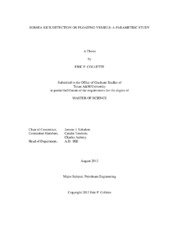| dc.description.abstract | Well control in drilling operations is priority to personnel safety. Detection of kicks, or the unscheduled entry of formation fluids into the wellbore, is vital to well control. It has been determined that return flow rate is the parameter most sensitive to detecting kicks and lost circulation. One kick detection method associated with this parameter is delta flow early kick detection or simply the delta flow method. This method has limitations on floating vessels. Inaccurate readings can occur due to the heave motion of a vessel. This is a result of the sensor being downstream of the compensatory slip joint. Expansion and compression of this joint can result in return flow readings that are not representative of the actual value. Inaccurate readings could create situations in which a false kick or false lost circulation is detected. Other inaccurate readings could result in an actual kick or lost circulation situation not being detected. In the past, work has been done to address this by developing a sensor that adjusts for heave. This work supports a project aimed at removing the need for motion compensation by relocating the sensor to a location independent of this motion.
A company is currently developing a delta flow early kick detection sensor to be placed at or near the seafloor. The stationary location of this sensor aims to remove the inaccuracy caused by slip joint compensation of vessel movement. This work will consist of a parametric study on the relationship of various drilling system and kick parameters at the seafloor using a well control simulator. The goal is to understand these relationships and determine the delta flow accuracy required based on a given kick size. As a result, this study found that a sensor capable of detecting a 10 barrel kick would require an accuracy of 2.4% and a 20 barrel kick would require a 4.6% accuracy for detection. This case was a shallow water, low kick intensity scenario. This accuracy and the others reported for the drilling and kick parameter ranges provide the boundaries for a well control sensor to be placed at the seafloor. | en |


